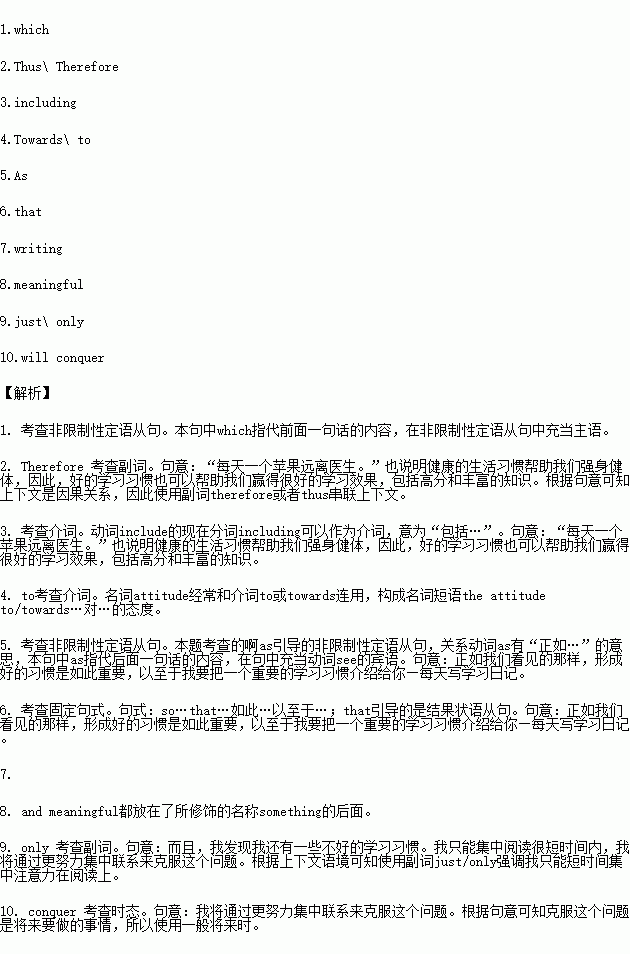题目内容
阅读下面材料,在空白处填入适当的内容 (不多于3个单词) 或括号内单词的正确形式。
How Learning Habits Influence On Learning Results. It is useful and necessary to discuss learning habits. There is a famous saying “Good habits lead to good endings”, 1. shows the importance of habits.
“An apple a day keeps doctor away” also shows how a healthy everyday habit helps to build up our body.2., good learning habits can help us gain great learning results 3. (include) high scores and abundant knowledge. At first, learning habits form our ways of thinking and attitudes 4._ the content of our learning. Obviously, a good habit can help us to speed up to reach our destinations.5. we can see, cultivating a good habit is so important 6.I would like to introduce one kind of good learning habits --- --- keep a learning diary every day. We can start the habit by 7. (write) learning summary and remember to record something impressive and 8. (mean). Keep it in mind, and gradually we can gain this good learning habit and benefit from it.
What`s more, I find out that I still have some bad learning habits as well. I can 9. concentrate on reading for a short time and I 10. (conquer) this problem by spending more effort on concentration practice.
I believe that through my efforts, I can gain good learning results by having good habits.
 名师伴你成长课时同步学练测系列答案
名师伴你成长课时同步学练测系列答案

 a photographic memory.
a photographic memory. ain impairment. Yet not all brain injury leads to savant skills. Some studies have shown that people who have purposeful interruption of the left side of the brain can develop idiot savant skills. However few people wish to participate in such experiments. There are many excellent reasons for not undergoing unnecessary experimentation on one’s brain. The term idiot savant is outdated and inappropriate. Virtually all savants have a high degree of intelligence and are thus not idiots.
ain impairment. Yet not all brain injury leads to savant skills. Some studies have shown that people who have purposeful interruption of the left side of the brain can develop idiot savant skills. However few people wish to participate in such experiments. There are many excellent reasons for not undergoing unnecessary experimentation on one’s brain. The term idiot savant is outdated and inappropriate. Virtually all savants have a high degree of intelligence and are thus not idiots. the stars in outer space. Photos also tell stories.
the stars in outer space. Photos also tell stories. Each picture is like a chapter in a book, which can do more than record the facts. It can also be a strong force for social change.
Each picture is like a chapter in a book, which can do more than record the facts. It can also be a strong force for social change. rofessors expect students to use computers to do homework or to complete projects. Since students are competing for good grades, those who have limited access to computers are at a great disadvantage. Furthermore, being able to do projects using the computer enhances the process of learning.
rofessors expect students to use computers to do homework or to complete projects. Since students are competing for good grades, those who have limited access to computers are at a great disadvantage. Furthermore, being able to do projects using the computer enhances the process of learning. s their learning process by making the process easier, more interesting, more engaging, and in the process enhancing their quality of life.
s their learning process by making the process easier, more interesting, more engaging, and in the process enhancing their quality of life. ity to help the students to prepare for their future
ity to help the students to prepare for their future


